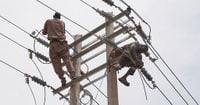On the battered streets of Khartoum, Sudan’s capital, the sounds of hammers, shovels, and voices ring out for the first time in years. After more than two years of devastating civil war between Sudan’s army and the paramilitary Rapid Support Forces (RSF), the city is finally witnessing the first flickers of reconstruction—a process that promises to be as arduous as it is essential.
The fighting, which erupted in April 2023 after long-standing tensions between the army and RSF boiled over, left Khartoum’s once vibrant neighborhoods pockmarked with bullet holes, collapsed buildings, and streets choked by fallen trees and broken power lines. The scars of war are everywhere: electrical poles lean at odd angles, cars sit burnt-out and abandoned, and entire residential blocks now stand with their exterior walls ripped away. According to AFP, the city’s skyline has become a jagged silhouette of destruction.
Yet, amid the devastation, hope is stirring. In March 2025, Sudan’s Armed Forces (SAF) regained control of Khartoum, pushing the RSF out after some of the war’s deadliest battles. Since then, government agencies and youth-led volunteer groups have begun the painstaking work of clearing debris, repairing hospitals, schools, and restoring water and power networks. “We are working to restore the state’s infrastructure,” said volunteer Mostafa Awad, as quoted by Arab News. Hundreds of volunteers have rolled up their sleeves, determined to reclaim their city from the rubble.
The scale of the task is daunting. The United Nations estimates that rehabilitating Khartoum’s essential facilities will cost around $350 million, while full rebuilding could run into several billion dollars and take years. The UN expects up to two million people to return to Khartoum by the end of 2025, half of the approximately four million who fled when fighting engulfed the city. For now, tens of thousands have already come back, braving the risks and hardships in hopes of rebuilding their lives.
But the dangers are far from over. The UN warns that Khartoum is “heavily contaminated by unexploded ordnance,” with tens of thousands of bombs and land mines left behind by fighters. Just this month, land mines were discovered scattered across the capital, making the work of clearing and rebuilding perilous. “Danger remains within the soot-stained buildings as authorities slowly work to clear tens of thousands of unexploded bombs left behind by fighters,” Arab News reported.
The war has left a staggering human toll. Humanitarian organizations estimate that tens of thousands have been killed, while the number of displaced has reached 13 million—creating what the UN has called the world’s worst hunger and displacement crisis. Of those, four million were forced from Khartoum alone before the army regained control in March. Many have sought refuge in neighboring countries, while others wait for a chance to return home.
Khartoum’s infrastructure has been systematically looted and destroyed, exacerbating the city’s woes. “Normally in a war zone, you see massive destruction... but you hardly ever see what happened in Khartoum,” said Luca Renda, the UN’s resident and humanitarian coordinator, in an interview with AFP. “All the cables have been taken away from homes, all the pipes have been destroyed,” he added, describing the looting of both small and large-scale items. Paramilitary fighters stripped infrastructure bare, taking everything from medical equipment and water pumps to copper wiring. The head of east Khartoum’s electricity department, Mohamed Al-Bashir, described “massive damage” in the capital’s main transformer stations, noting that “some power stations were completely destroyed” and that the RSF had “specifically targeted transformer oil and copper cables.”
As a result, vast swathes of Khartoum remain without electricity or reliable water supply. The lack of basic services has had dire consequences: a cholera outbreak gripped the city in the summer of 2025, with health officials reporting up to 1,500 new cases a day in June, according to the UN. Many schools have been attacked or repurposed as shelters, while cultural sites such as the National Museum have been attacked or destroyed, as reported by UNESCO.
Yet, the spirit of the people endures. Despite immense challenges—including shortages of raw materials, infrastructure tools, sanitation supplies, and iron—volunteers and local authorities press on. “We faced challenges such as the lack of raw materials, especially infrastructure tools, sanitation (supplies) and iron,” said construction worker Mohamed El Ser to AFP. “Still, the market is relatively starting to recover.” On the ground, workers can be seen stacking bricks beside crumbling buildings, refitting pipes into what once were family homes, and hauling away debris from streets that had been front lines not long ago.
The government, too, is making moves to support recovery. On his first visit to Khartoum in July 2025, Prime Minister Kamil Idris pledged a wide-scale recovery effort, declaring, “Khartoum will return as a proud national capital.” The government has begun planning its return from its wartime base in Port Sudan and, on August 19, announced that central Khartoum—the devastated business and government district where some of the fiercest battles took place—would be evacuated and redesigned.
For those who have already returned, life remains difficult, but there are glimmers of progress. “Honestly, there is an improvement in living conditions,” said Ali Mohamed, a recent returnee, to Arab News. “There is more stability now, and real services are beginning to come back, like water, electricity and even basic medical care.”
The road ahead is long and fraught with obstacles. Restoring basic infrastructure will require not just money and materials, but also time, patience, and—perhaps most crucially—the resilience of Khartoum’s people. The UN, local authorities, and volunteers are committed to seeing the city rise from the ashes, but the full rebuilding of Khartoum will take years and the cooperation of many. The hope is that, one day, the city will once again be a bustling metropolis, its streets filled not with the echoes of war, but with the everyday sounds of life returning to normal.
For now, the first bricks are being laid, and Khartoum’s long journey back has begun.

